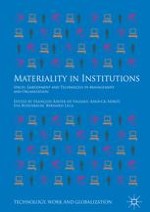2019 | OriginalPaper | Chapter
11. The Heart Is a Hand Grenade: Plastic Figurations of Bodies at War
Authors : Sine Nørholm Just, Line Kirkegaard
Published in: Materiality in Institutions
Publisher: Springer International Publishing
Activate our intelligent search to find suitable subject content or patents.
Select sections of text to find matching patents with Artificial Intelligence. powered by
Select sections of text to find additional relevant content using AI-assisted search. powered by
